
+6
Gypsy
zdeekie
Topdog
searcher
Mcqueen
3rdforum
10 posters
Iconic Photographs

Campbell Brodie-


 Posts : 59106
Posts : 59106
Join date : 2011-08-13
Age : 69
Location : Scotland
- Post n°401
 Re: Iconic Photographs
Re: Iconic Photographs
We'll never know... 


3rdforum-


 Posts : 22953
Posts : 22953
Join date : 2011-08-30
Age : 54
Location : Ireland
- Post n°402
 Re: Iconic Photographs
Re: Iconic Photographs
Answer is buried somewhere in Area 51

Campbell Brodie-


 Posts : 59106
Posts : 59106
Join date : 2011-08-13
Age : 69
Location : Scotland
- Post n°403
 Re: Iconic Photographs
Re: Iconic Photographs
Marilyn Monroe performing for the thousands of American troops in Korea, 1954.
In February 1954, actress Marilyn Monroe traveled to Korea to entertain the American troops. She performed a quickly thrown-together show titled Anything Goes to audiences which totaled over 100,000 troops over 4 days. Then tour was also a chance for the film star to overcome a degree of stage fright. She remarked that the Korea trip “was the best thing that ever happened to me. I never felt like a star before in my heart. It was so wonderful to look down and see a fellow smiling at me”.
In one show where the start was delayed the troops got frustrated and threatened to riot so the opening acts had to be cancelled to get her onto the stage sooner. The crowed adored her and they truly enjoyed her visit. She looked amazing on her baggy army uniform. Ted Sherman, who served in the Navy during World War II and Korea, recalled: “I was with a group of Navy guys who happened to be at Daegu Air Force Base when we heard Marilyn would entertain there that night. We convinced our transport pilot to find something wrong with our R4D transport, so we could delay the return flight to our ship in Tokyo Bay for that one night. It was a great evening for all the homesick guys who were dazzled by the movie star’s performance. The sight and sounds of Marilyn singing ‘Diamonds Are a Girl’s Best Friend’ is a memory I still cherish”.
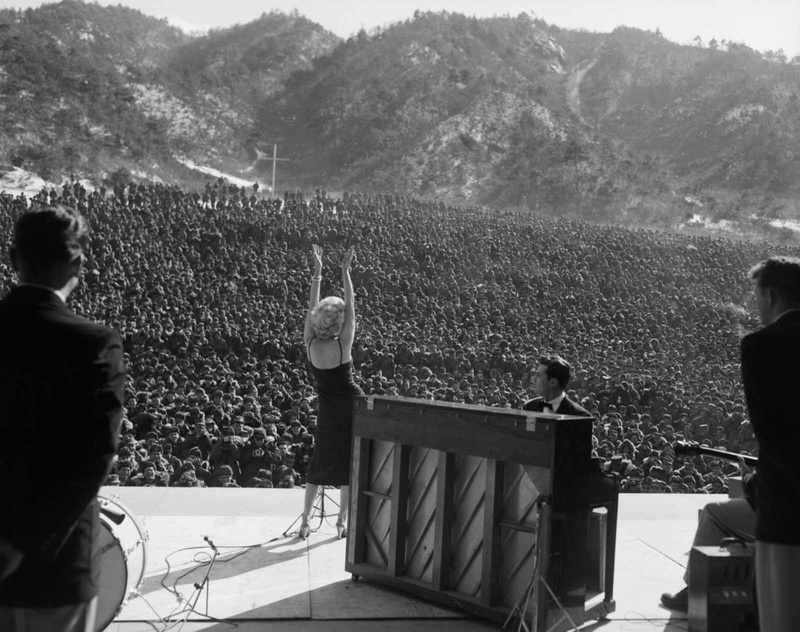
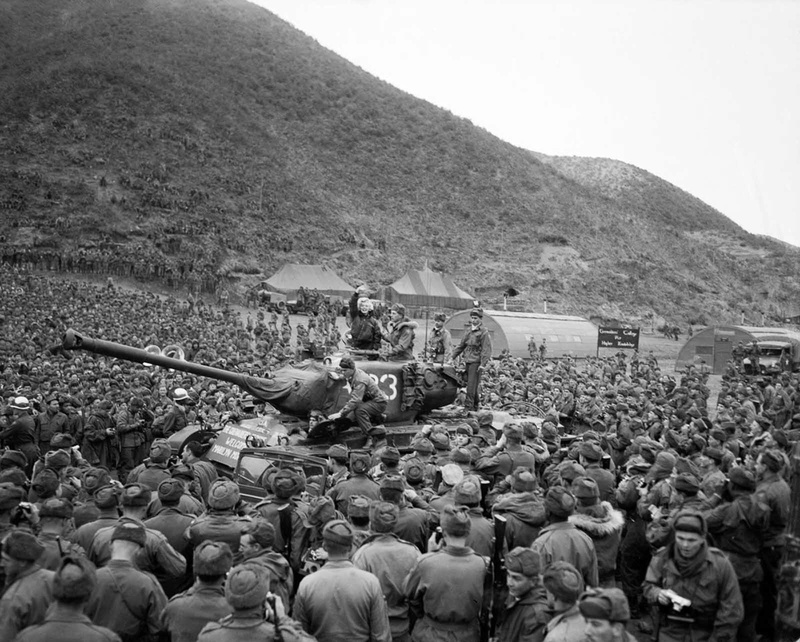

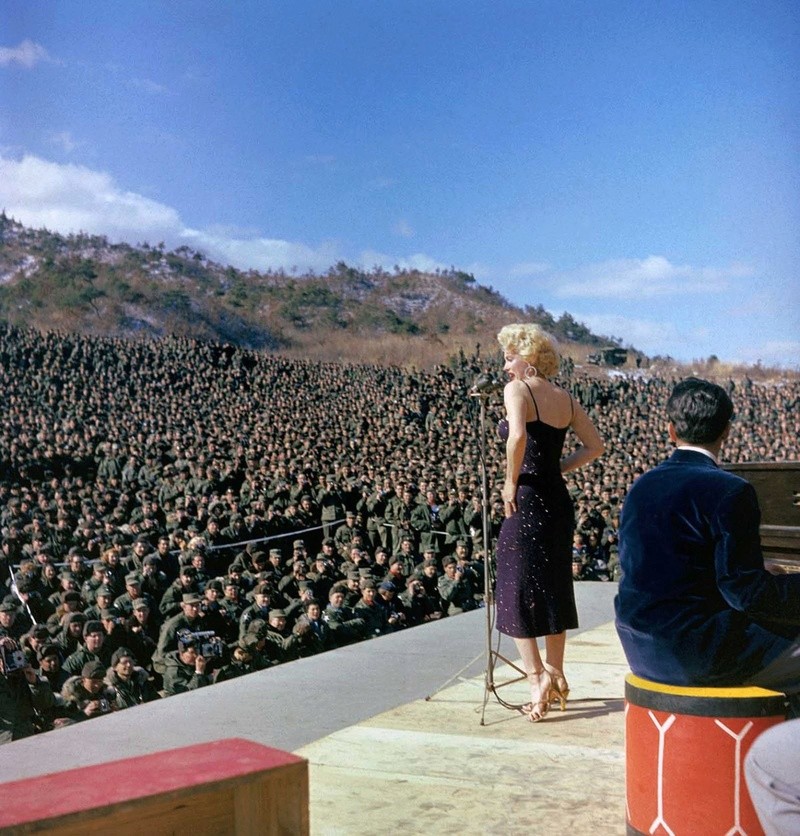
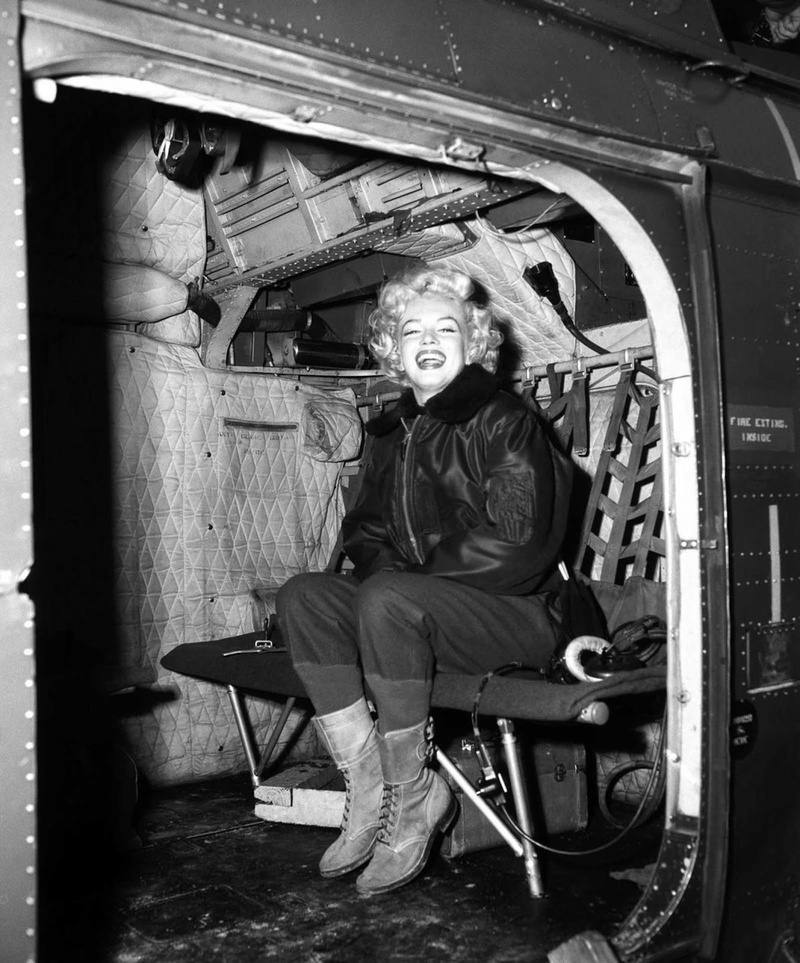
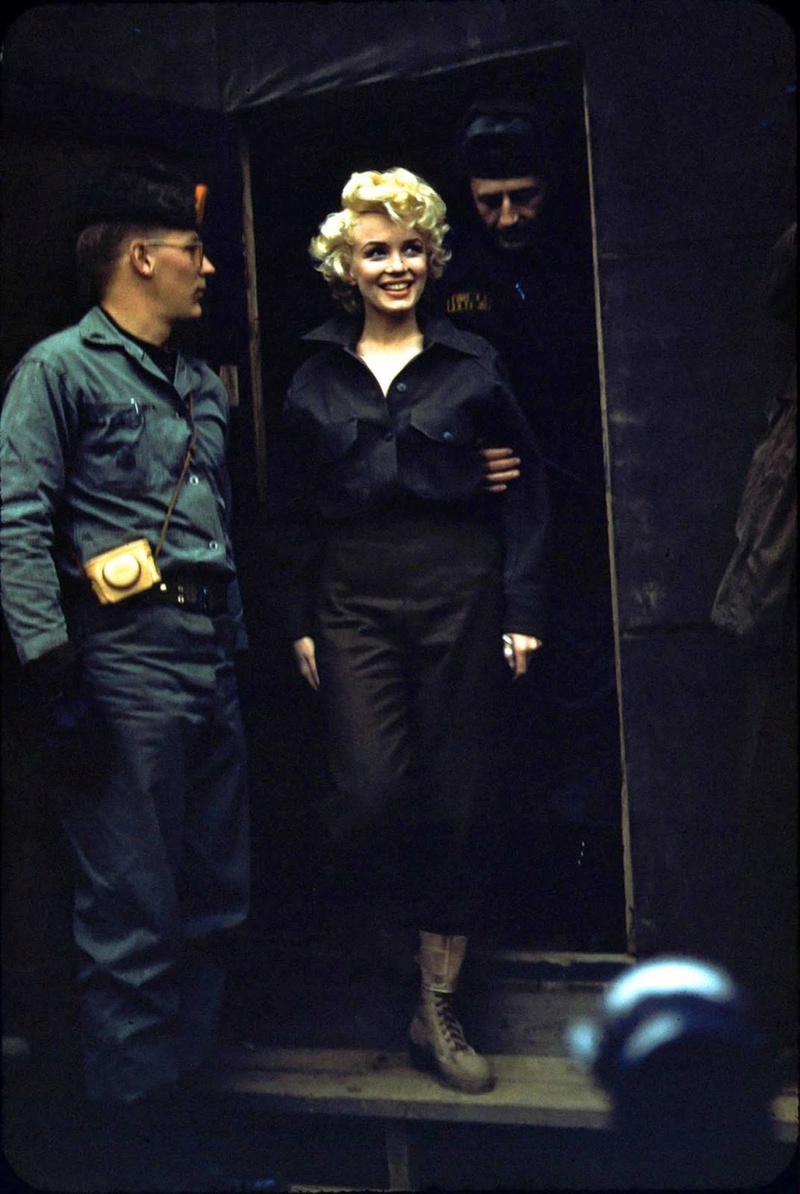
In February 1954, actress Marilyn Monroe traveled to Korea to entertain the American troops. She performed a quickly thrown-together show titled Anything Goes to audiences which totaled over 100,000 troops over 4 days. Then tour was also a chance for the film star to overcome a degree of stage fright. She remarked that the Korea trip “was the best thing that ever happened to me. I never felt like a star before in my heart. It was so wonderful to look down and see a fellow smiling at me”.
In one show where the start was delayed the troops got frustrated and threatened to riot so the opening acts had to be cancelled to get her onto the stage sooner. The crowed adored her and they truly enjoyed her visit. She looked amazing on her baggy army uniform. Ted Sherman, who served in the Navy during World War II and Korea, recalled: “I was with a group of Navy guys who happened to be at Daegu Air Force Base when we heard Marilyn would entertain there that night. We convinced our transport pilot to find something wrong with our R4D transport, so we could delay the return flight to our ship in Tokyo Bay for that one night. It was a great evening for all the homesick guys who were dazzled by the movie star’s performance. The sight and sounds of Marilyn singing ‘Diamonds Are a Girl’s Best Friend’ is a memory I still cherish”.







Mcqueen-


 Posts : 30546
Posts : 30546
Join date : 2011-08-13
Age : 70
Location : England
- Post n°404
 Re: Iconic Photographs
Re: Iconic Photographs
She saw some traffic that girl 


Campbell Brodie-


 Posts : 59106
Posts : 59106
Join date : 2011-08-13
Age : 69
Location : Scotland
- Post n°405
 Re: Iconic Photographs
Re: Iconic Photographs
So did Eva Peron...

Mcqueen-


 Posts : 30546
Posts : 30546
Join date : 2011-08-13
Age : 70
Location : England
- Post n°406
 Re: Iconic Photographs
Re: Iconic Photographs
Never met her, Is she local 


Campbell Brodie-


 Posts : 59106
Posts : 59106
Join date : 2011-08-13
Age : 69
Location : Scotland
- Post n°407
 Re: Iconic Photographs
Re: Iconic Photographs
Watch the Madonna film. Surprisingly good.

Adam Mint-


 Posts : 23101
Posts : 23101
Join date : 2011-10-07
Age : 59
- Post n°408
 Re: Iconic Photographs
Re: Iconic Photographs
Feck me when I was reading the article guess who came to my mind...

Campbell Brodie-


 Posts : 59106
Posts : 59106
Join date : 2011-08-13
Age : 69
Location : Scotland
- Post n°409
 Re: Iconic Photographs
Re: Iconic Photographs
Ku Klux Klan on a ferris wheel, 1926. (KLANgers day out?)
On April 27, 1926, the Cañon City Daily Record ran a surprising bulletin on its front page. Right under a notice that the local junior high school was putting together a variety show, the local newspaper of the small central Colorado town printed the headline “Klansmen pose for picture on merry-go-round”, along with a brief, staid description of a parade of hooded locals that went from the Klan headquarters on Main Street to the travelling amusement park that had been set up a couple blocks away.
However, that photo wasn’t actually printed along with the headline (the photographer didn’t share it). But when the photo came to light more than 65 years later, it served as a reminder of the history of Ku Klux Klan.
To understand how a picture of 41 Klansmen on a Ferris wheel came to be, you first have to understand the background of the KKK in Colorado. Cañon City was the Klan capital of the State from 1924 to 1928: Colorado Governor Clarence Morley was a Klansman, Colorado Senator Rice Means was endorsed by the KKK, Denver Mayor Benjamin Stapleton was connected with the Klan, and the Grand Dragon of the Colorado Klan, Reverend Fred Arnold, was the minister of Cañon City’s First Baptist Church.
By the time this photo was taken in 1926, the Klan’s power was at its zenith. According to the Daily Record, the Klansmen were invited to pose for the portrait by the site’s proprietor, William Forsythe, a Klansman himself, who brought his mini-carnival down south from Fort Collins.
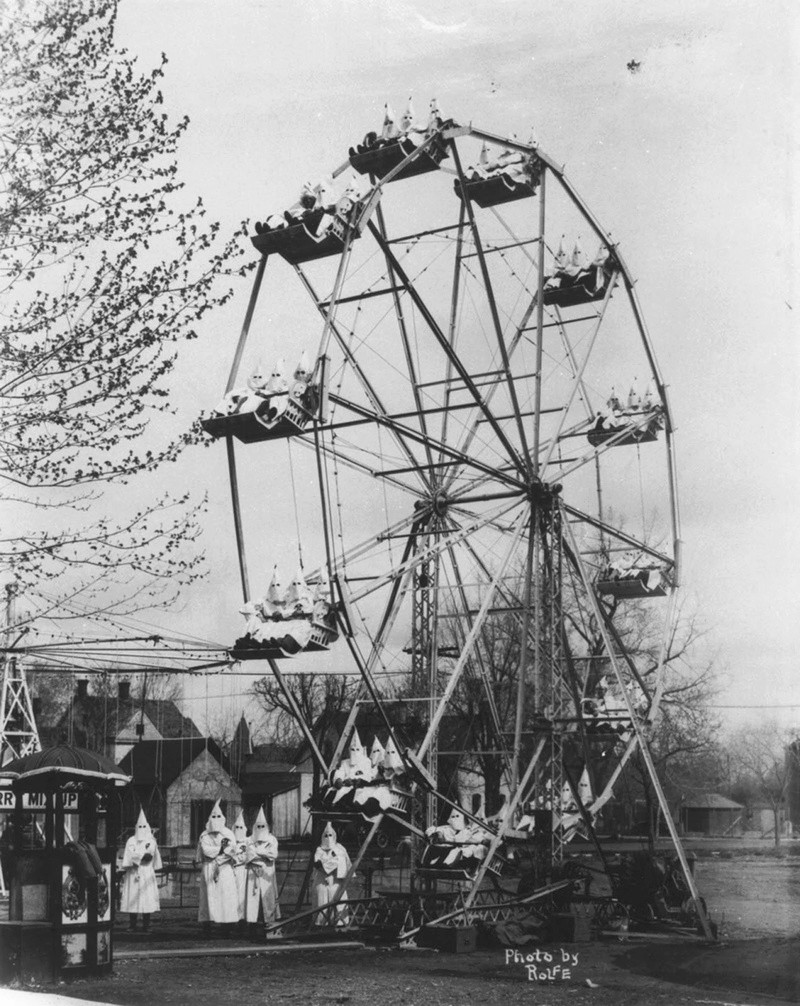
On April 27, 1926, the Cañon City Daily Record ran a surprising bulletin on its front page. Right under a notice that the local junior high school was putting together a variety show, the local newspaper of the small central Colorado town printed the headline “Klansmen pose for picture on merry-go-round”, along with a brief, staid description of a parade of hooded locals that went from the Klan headquarters on Main Street to the travelling amusement park that had been set up a couple blocks away.
However, that photo wasn’t actually printed along with the headline (the photographer didn’t share it). But when the photo came to light more than 65 years later, it served as a reminder of the history of Ku Klux Klan.
To understand how a picture of 41 Klansmen on a Ferris wheel came to be, you first have to understand the background of the KKK in Colorado. Cañon City was the Klan capital of the State from 1924 to 1928: Colorado Governor Clarence Morley was a Klansman, Colorado Senator Rice Means was endorsed by the KKK, Denver Mayor Benjamin Stapleton was connected with the Klan, and the Grand Dragon of the Colorado Klan, Reverend Fred Arnold, was the minister of Cañon City’s First Baptist Church.
By the time this photo was taken in 1926, the Klan’s power was at its zenith. According to the Daily Record, the Klansmen were invited to pose for the portrait by the site’s proprietor, William Forsythe, a Klansman himself, who brought his mini-carnival down south from Fort Collins.


Mcqueen-


 Posts : 30546
Posts : 30546
Join date : 2011-08-13
Age : 70
Location : England
- Post n°410
 Re: Iconic Photographs
Re: Iconic Photographs
Now what do they remind me of  except in black
except in black 
 except in black
except in black 

Campbell Brodie-


 Posts : 59106
Posts : 59106
Join date : 2011-08-13
Age : 69
Location : Scotland
- Post n°411
 Re: Iconic Photographs
Re: Iconic Photographs
A unknown man during the Great Depression, 1932.
In 1932-1933, at the worst point in the Great Depression years, unemployment rates in the United States reached almost 25%, with more than 11 million people looking for work. Farmers who had lost their land and homes to foreclosure as a result of the Dust Bowl made up a large part of the idle workforce. “Hoovervilles” (named after Herbert Hoover, the American president many blamed for the Great Depression) and shantytowns sprung up all across America, areas in which people gathered and constructed makeshift homes out of boxes, packing crates, abandoned cars, and scraps of wood.
Between 1929 and 1932, incomes, on average, were reduced by 40%. Deflation took hold, reducing prices by 10% per year on goods. Foreclosures rose sharply. By 1934, nearly one-half of all residential loans were delinquent and over 1 million families lost their farms. In 1932 alone, 273,000 families were evicted from their homes. Between 1929 and 1932, construction of homes dropped by an incredible 80%.
The Great Plain States were hit even harder than other states. This is because they were hit by a severe drought. Many companies were forced to close, due to the economic environment. Banks were closing at an alarming rate and in 1933 alone, more than 4,000 banks closed. By 1933, the GDP fell 33%. During the Great Depression, there were 2 million homeless people in the United States. The stock market hit a low in 1932 closing at 41.22, down 89.2% from its all-time high.
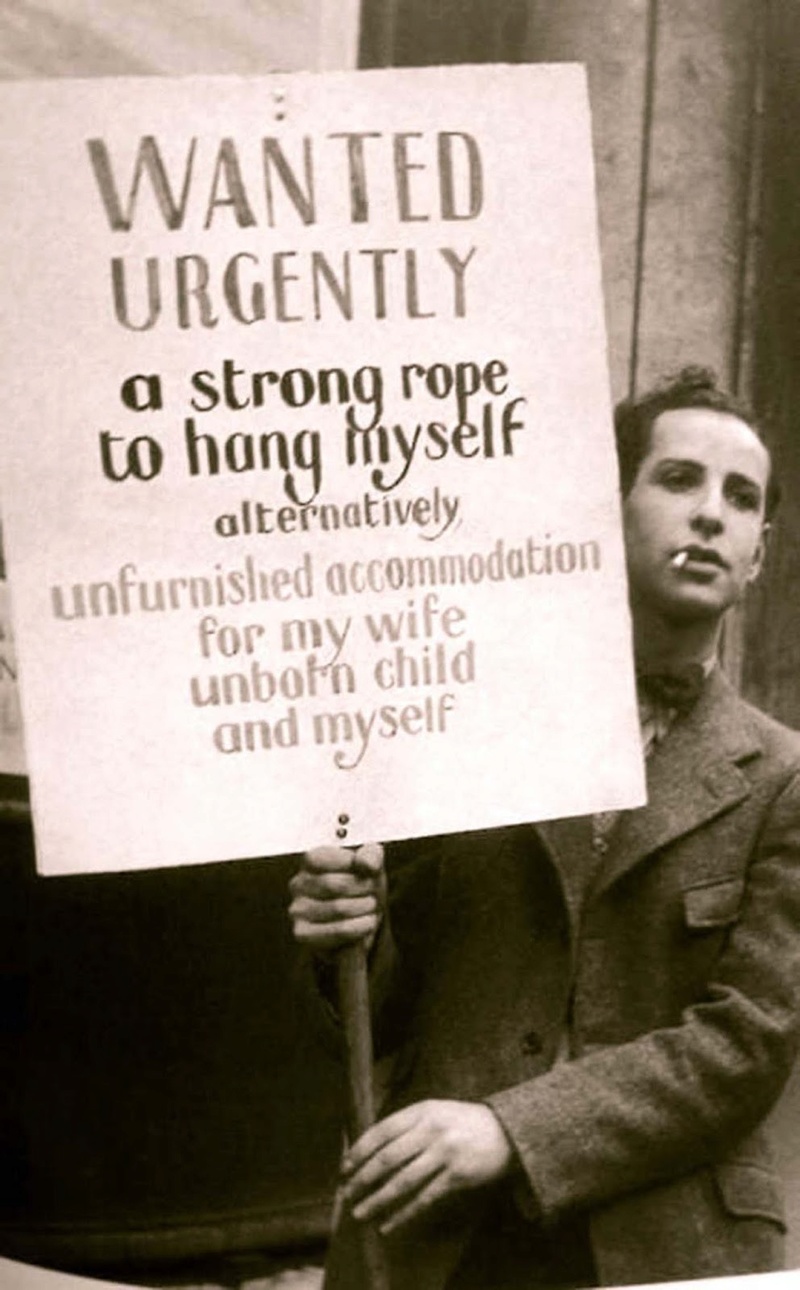
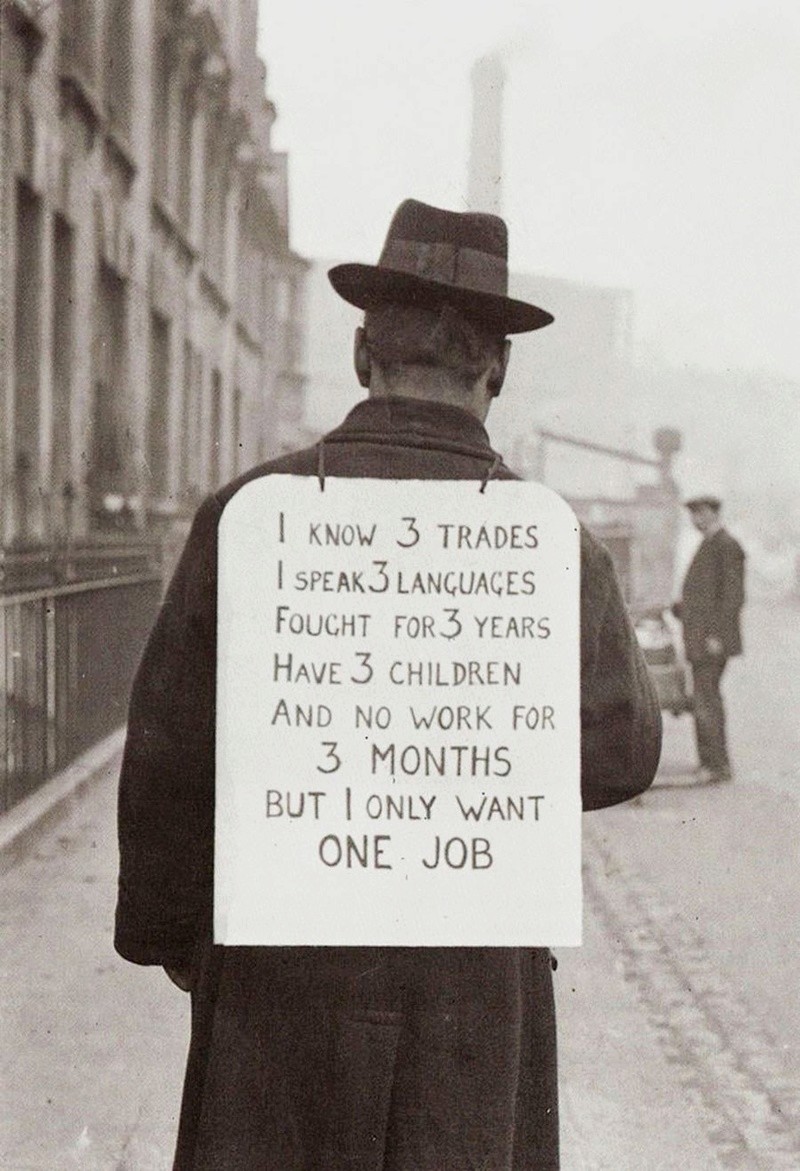
In 1932-1933, at the worst point in the Great Depression years, unemployment rates in the United States reached almost 25%, with more than 11 million people looking for work. Farmers who had lost their land and homes to foreclosure as a result of the Dust Bowl made up a large part of the idle workforce. “Hoovervilles” (named after Herbert Hoover, the American president many blamed for the Great Depression) and shantytowns sprung up all across America, areas in which people gathered and constructed makeshift homes out of boxes, packing crates, abandoned cars, and scraps of wood.
Between 1929 and 1932, incomes, on average, were reduced by 40%. Deflation took hold, reducing prices by 10% per year on goods. Foreclosures rose sharply. By 1934, nearly one-half of all residential loans were delinquent and over 1 million families lost their farms. In 1932 alone, 273,000 families were evicted from their homes. Between 1929 and 1932, construction of homes dropped by an incredible 80%.
The Great Plain States were hit even harder than other states. This is because they were hit by a severe drought. Many companies were forced to close, due to the economic environment. Banks were closing at an alarming rate and in 1933 alone, more than 4,000 banks closed. By 1933, the GDP fell 33%. During the Great Depression, there were 2 million homeless people in the United States. The stock market hit a low in 1932 closing at 41.22, down 89.2% from its all-time high.



Mcqueen-


 Posts : 30546
Posts : 30546
Join date : 2011-08-13
Age : 70
Location : England
- Post n°412
 Re: Iconic Photographs
Re: Iconic Photographs
Move

Campbell Brodie-


 Posts : 59106
Posts : 59106
Join date : 2011-08-13
Age : 69
Location : Scotland
- Post n°413
 Re: Iconic Photographs
Re: Iconic Photographs
Second guy has an unhealthy obsession with the number 3... 


Campbell Brodie-


 Posts : 59106
Posts : 59106
Join date : 2011-08-13
Age : 69
Location : Scotland
- Post n°414
 Re: Iconic Photographs
Re: Iconic Photographs
Unboxing the Statue of Liberty, 1885.
The Statue of Liberty was completed in Paris in June 1884, presented to America by the people of France on July 4, 1884. The copper statue is of a robed female figure representing Libertas, the Roman goddess, who bears a torch and a tabula ansata (a tablet evoking the law) upon which is inscribed the date of the American Declaration of Independence, July 4, 1776.
Designed by Frédéric Auguste Bartholdi and built by Gustave Eiffel, the statue was dismantled and shipped to US in early 1885. The finished statue consisted of 350 individual pieces shipped to the US in 214 crates.
On June 17, 1885, the French steamer Isère, laden with the Statue of Liberty, reached the New York port safely. New Yorkers displayed their new-found enthusiasm for the statue, as the French vessel arrived with the crates holding the disassembled statue on board. Two hundred thousand people lined the docks and hundreds of boats put to sea to welcome the Isère.
After five months of daily calls to donate to the statue fund, on August 11, 1885, the World announced that $102,000 had been raised from 120,000 donors, and that 80 percent of the total had been received in sums of less than one dollar.
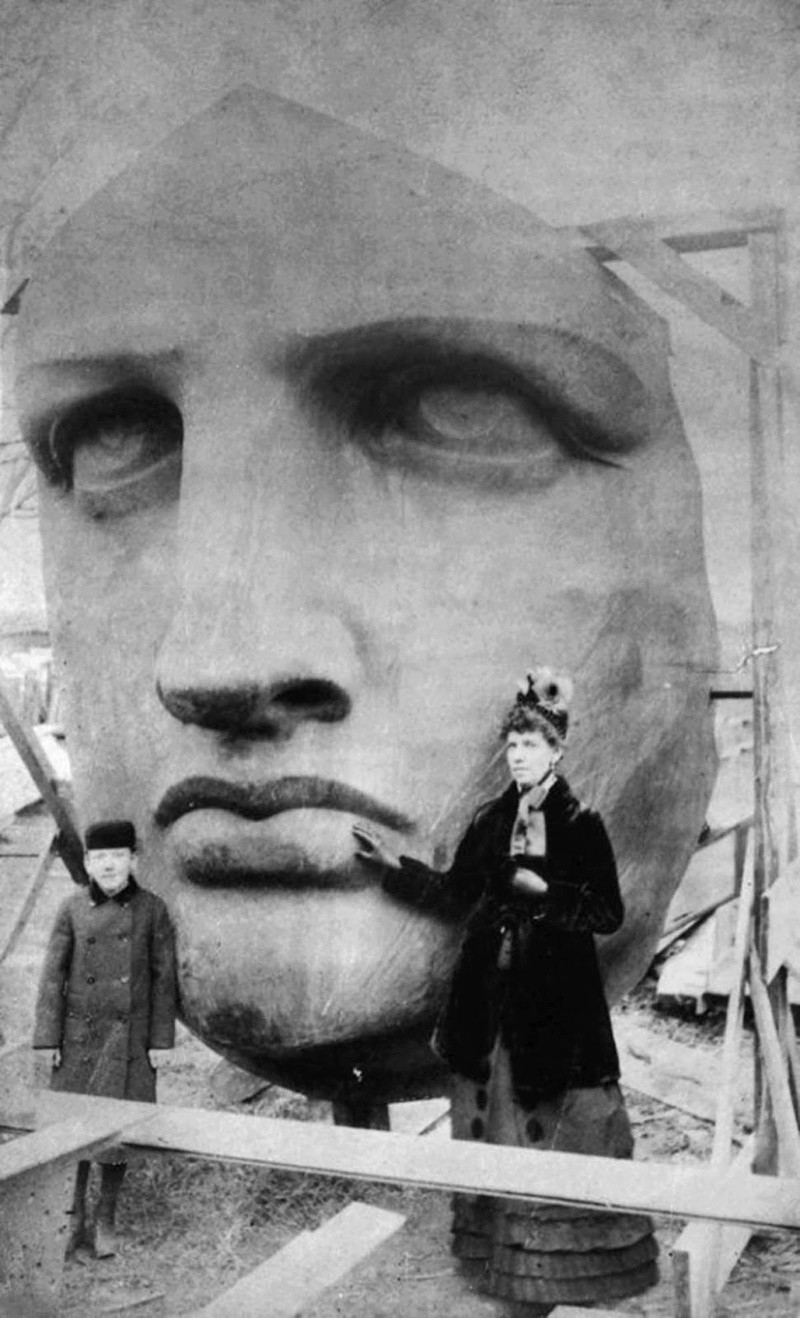

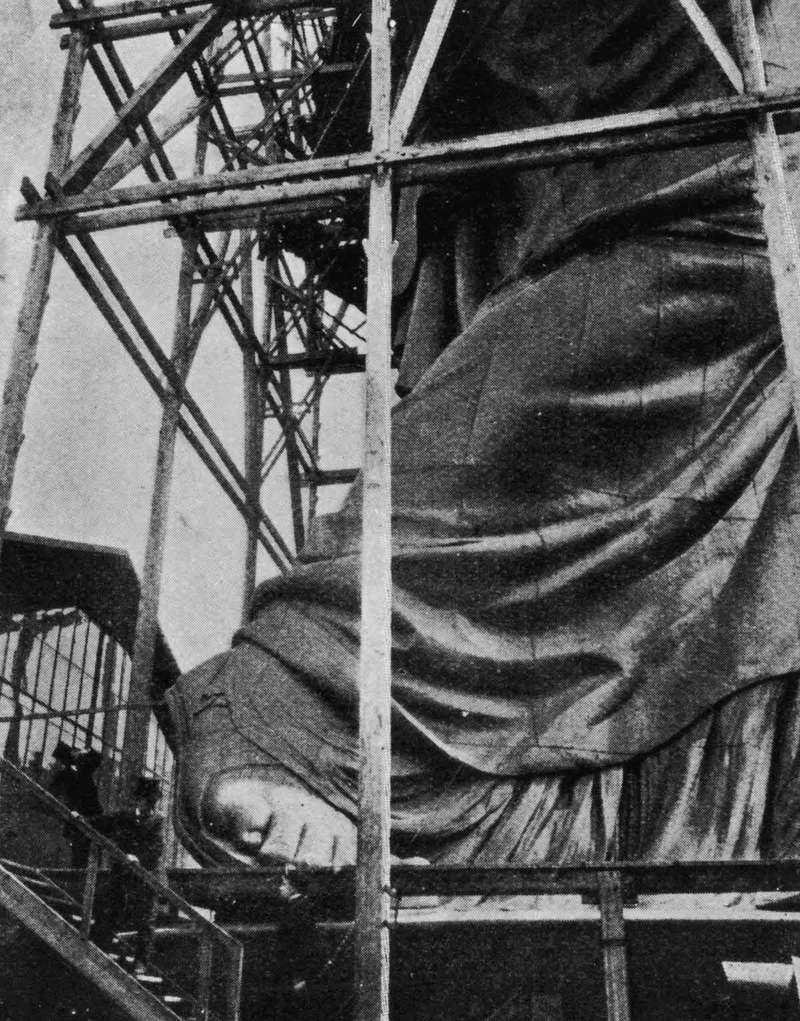
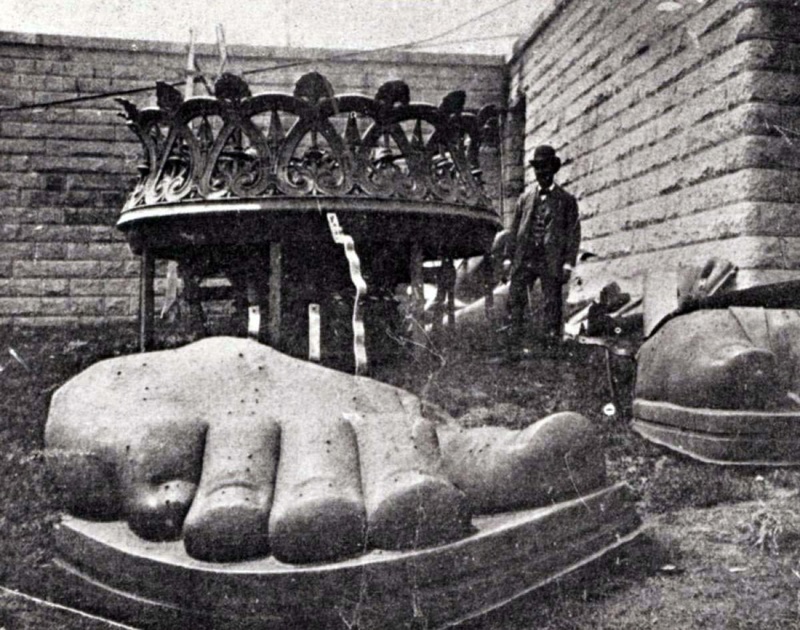
The Statue of Liberty was completed in Paris in June 1884, presented to America by the people of France on July 4, 1884. The copper statue is of a robed female figure representing Libertas, the Roman goddess, who bears a torch and a tabula ansata (a tablet evoking the law) upon which is inscribed the date of the American Declaration of Independence, July 4, 1776.
Designed by Frédéric Auguste Bartholdi and built by Gustave Eiffel, the statue was dismantled and shipped to US in early 1885. The finished statue consisted of 350 individual pieces shipped to the US in 214 crates.
On June 17, 1885, the French steamer Isère, laden with the Statue of Liberty, reached the New York port safely. New Yorkers displayed their new-found enthusiasm for the statue, as the French vessel arrived with the crates holding the disassembled statue on board. Two hundred thousand people lined the docks and hundreds of boats put to sea to welcome the Isère.
After five months of daily calls to donate to the statue fund, on August 11, 1885, the World announced that $102,000 had been raised from 120,000 donors, and that 80 percent of the total had been received in sums of less than one dollar.





Campbell Brodie-


 Posts : 59106
Posts : 59106
Join date : 2011-08-13
Age : 69
Location : Scotland
- Post n°415
 Re: Iconic Photographs
Re: Iconic Photographs
Is it me or does she look like Elvis? 


Mcqueen-


 Posts : 30546
Posts : 30546
Join date : 2011-08-13
Age : 70
Location : England
- Post n°417
 Re: Iconic Photographs
Re: Iconic Photographs
So thats where the kent wentCampbell Brodie wrote:Is it me or does she look like Elvis?


Campbell Brodie-


 Posts : 59106
Posts : 59106
Join date : 2011-08-13
Age : 69
Location : Scotland
- Post n°418
 Re: Iconic Photographs
Re: Iconic Photographs
A Vietnamese mother and her children wade across a river, fleeing a bombing raid on Qui Nhon by United States aircraft on September 7, 1965.
Photo depicts a South Vietnamese mother fleeing through a river. She and her four children were forced to leave their village, Qui Nhon, near Quinbonso. The U.S. Air Force had asked all inhabitants to evacuate the village because the Vietcong had been using it as a base camp to fire at the U.S. Marines.
This picture was 1966 World Press Photo of the Year. After he won the prize, photographer Kyoichi Sawada searched and located the two families in the picture and gave them all the prize money, and each a copy of the photograph. Four years later in Cambodia, 1970, photographer Kyoichi Sawada died in the field, doing what he loved most.
The American base was under constant attack from Viet Cong snipers, hiding in the surrounding villages. Now the Americans were striking back, at the same time destroying the village. The attack was part of an elaborate clearing operation, whose purpose it was to drive the Vietcong members out of the coastal area in South Vietnam. The assault was named Operation Piranha after the dangerous South American fish. lt employed more than 5,000 troops. In each village that was believed to shelter Vietcong guerillas. Women and children were advised to leave before the attack would commence. The Communists fighters often used women and children as a screen for their operations.
Operation Piranha concluded on 10 September, 178 VC had been killed and 360 enemy and suspected enemy had been captured. Allied losses were two Marines and five South Vietnamese killed. The operation failed to wipe out the 1st Viet Cong Regiment (the primary target), villagers told the Marines that Vietcong units had been in the area but had left, some less than 24 hours before Operation Piranha had commenced.
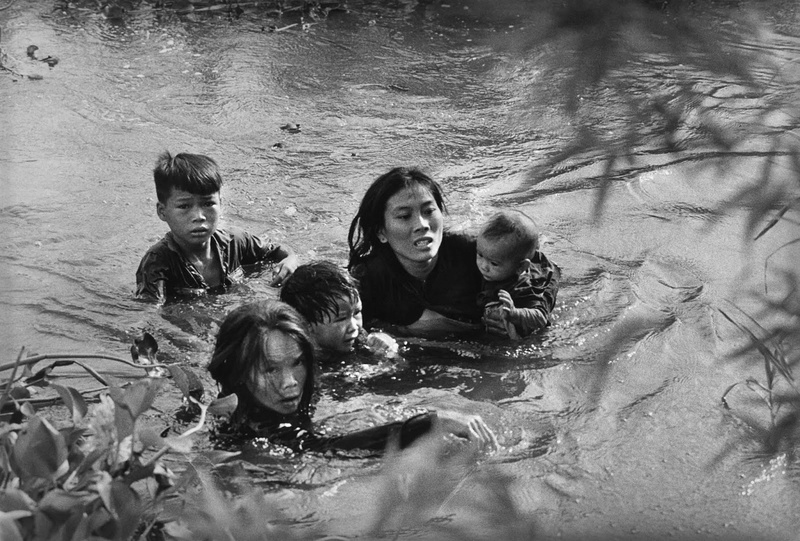
Photo depicts a South Vietnamese mother fleeing through a river. She and her four children were forced to leave their village, Qui Nhon, near Quinbonso. The U.S. Air Force had asked all inhabitants to evacuate the village because the Vietcong had been using it as a base camp to fire at the U.S. Marines.
This picture was 1966 World Press Photo of the Year. After he won the prize, photographer Kyoichi Sawada searched and located the two families in the picture and gave them all the prize money, and each a copy of the photograph. Four years later in Cambodia, 1970, photographer Kyoichi Sawada died in the field, doing what he loved most.
The American base was under constant attack from Viet Cong snipers, hiding in the surrounding villages. Now the Americans were striking back, at the same time destroying the village. The attack was part of an elaborate clearing operation, whose purpose it was to drive the Vietcong members out of the coastal area in South Vietnam. The assault was named Operation Piranha after the dangerous South American fish. lt employed more than 5,000 troops. In each village that was believed to shelter Vietcong guerillas. Women and children were advised to leave before the attack would commence. The Communists fighters often used women and children as a screen for their operations.
Operation Piranha concluded on 10 September, 178 VC had been killed and 360 enemy and suspected enemy had been captured. Allied losses were two Marines and five South Vietnamese killed. The operation failed to wipe out the 1st Viet Cong Regiment (the primary target), villagers told the Marines that Vietcong units had been in the area but had left, some less than 24 hours before Operation Piranha had commenced.


Campbell Brodie-


 Posts : 59106
Posts : 59106
Join date : 2011-08-13
Age : 69
Location : Scotland
- Post n°419
 Re: Iconic Photographs
Re: Iconic Photographs
SS Morro Castle burnt and shipwrecked off the coast of New Jersey, 1934.
The SS Morro Castle, named after a fortress that guards Havana Bay, was a luxury cruise ship of the 1930s that was built for the Ward Line for runs between New York City and Havana. On the morning of September 8, 1934, en route from Havana to New York, the ship caught fire and burned, killing 137 passengers and crew members.
At around 2:50 a.m. on September 8, while the ship was sailing around eight nautical miles off Long Beach Island, a fire was detected in a storage locker within the First Class Writing Room on B Deck. Within the next 30 minutes, the Morro Castle became engulfed in flames. As the fire grew in intensity, acting Captain Warms attempted to beach the ship, but the growing need to launch lifeboats and abandon ship forced him to give up this strategy. Within 20 minutes of the fire’s discovery (at about 3:10), the fire burned through the ship’s main electrical cables, plunging the ship into darkness.
By mid-morning, the ship was totally abandoned and its burning hull drifted ashore, coming to a stop in shallow water off Asbury Park, New Jersey.
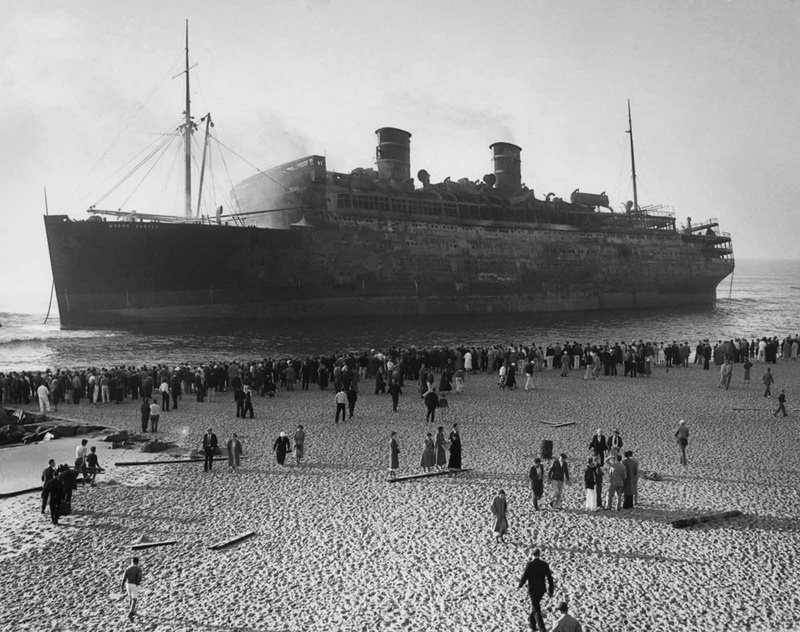
Despite attempts to tow her to a safer location, the ship continued to drift toward shore. As telephone calls and radio stations spread news of the disaster along the New Jersey coast, local citizens assembled on the coastline to nurse the wounded, retrieve the dead, and try to unite families that had been scattered among different rescue boats that landed on the New Jersey beaches. By mid-morning, the ship was totally abandoned and its burning hull drifted ashore, coming to a stop in shallow water off Asbury Park, New Jersey, late that afternoon at almost the exact spot where the New Era had wrecked in 1854. The fires continued to smolder for the next two days, and in the end, 135 passengers and crew (out of a total of 549) were lost.
The ship was declared a total loss, and its charred hulk was finally towed away from the Asbury Park shoreline on March 14, 1935. According to one account, it later started settling by the stern and sank while being towed up the river.
In the intervening months, because of its proximity to the boardwalk and the Asbury Park Convention Hall pier, from which it was possible to wade out and touch the wreck with one’s hands, the wreck was treated as a destination for sightseeing trips, complete with stamped penny souvenirs and postcards for sale.
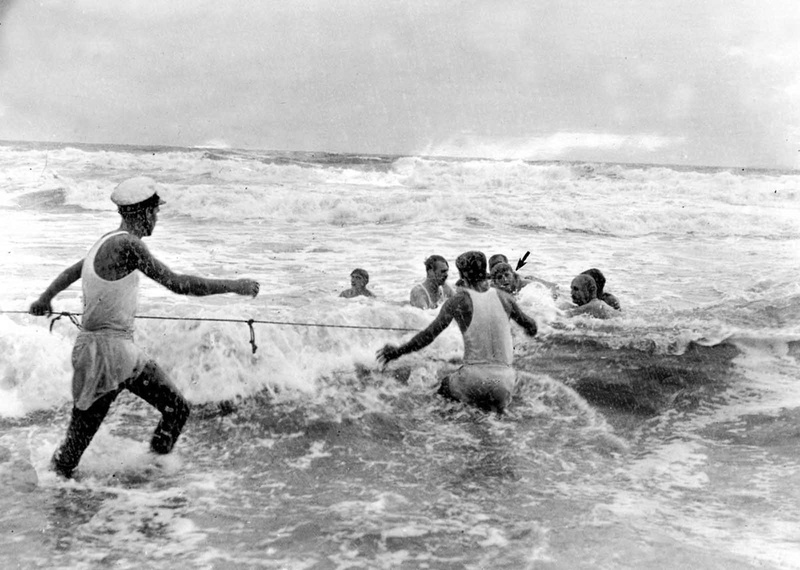
Survivors are treated in the Spring Lake, New Jersey firehouse.
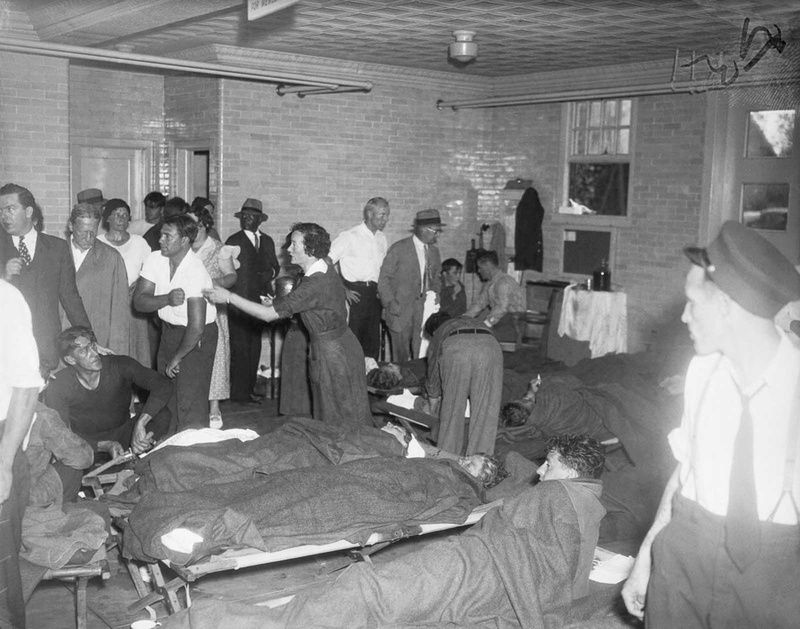
The ship comes to rest on the beach at Asbury Park, New Jersey.

The SS Morro Castle, named after a fortress that guards Havana Bay, was a luxury cruise ship of the 1930s that was built for the Ward Line for runs between New York City and Havana. On the morning of September 8, 1934, en route from Havana to New York, the ship caught fire and burned, killing 137 passengers and crew members.
At around 2:50 a.m. on September 8, while the ship was sailing around eight nautical miles off Long Beach Island, a fire was detected in a storage locker within the First Class Writing Room on B Deck. Within the next 30 minutes, the Morro Castle became engulfed in flames. As the fire grew in intensity, acting Captain Warms attempted to beach the ship, but the growing need to launch lifeboats and abandon ship forced him to give up this strategy. Within 20 minutes of the fire’s discovery (at about 3:10), the fire burned through the ship’s main electrical cables, plunging the ship into darkness.
By mid-morning, the ship was totally abandoned and its burning hull drifted ashore, coming to a stop in shallow water off Asbury Park, New Jersey.

Despite attempts to tow her to a safer location, the ship continued to drift toward shore. As telephone calls and radio stations spread news of the disaster along the New Jersey coast, local citizens assembled on the coastline to nurse the wounded, retrieve the dead, and try to unite families that had been scattered among different rescue boats that landed on the New Jersey beaches. By mid-morning, the ship was totally abandoned and its burning hull drifted ashore, coming to a stop in shallow water off Asbury Park, New Jersey, late that afternoon at almost the exact spot where the New Era had wrecked in 1854. The fires continued to smolder for the next two days, and in the end, 135 passengers and crew (out of a total of 549) were lost.
The ship was declared a total loss, and its charred hulk was finally towed away from the Asbury Park shoreline on March 14, 1935. According to one account, it later started settling by the stern and sank while being towed up the river.
In the intervening months, because of its proximity to the boardwalk and the Asbury Park Convention Hall pier, from which it was possible to wade out and touch the wreck with one’s hands, the wreck was treated as a destination for sightseeing trips, complete with stamped penny souvenirs and postcards for sale.

Survivors are treated in the Spring Lake, New Jersey firehouse.

The ship comes to rest on the beach at Asbury Park, New Jersey.


Mcqueen-


 Posts : 30546
Posts : 30546
Join date : 2011-08-13
Age : 70
Location : England
- Post n°420
 Re: Iconic Photographs
Re: Iconic Photographs
Life boats my arse, I watch them ferries in and out with about 4 life boats, One day 


Campbell Brodie-


 Posts : 59106
Posts : 59106
Join date : 2011-08-13
Age : 69
Location : Scotland
- Post n°421
 Re: Iconic Photographs
Re: Iconic Photographs
A Native American overlooks the newly completed transcontinental railroad in Sacramento, c. 1867.
In this photograph by Alfred Hart taken between 1865 – 1869, a Native American looks down upon a newly completed section of the Transcontinental Railroad, 435 miles from Sacramento, California. The stark composition of both man and progress facing a distant haze conveys emotions as complex as the cultural impact behind America’s westward expansion. The railroad was a massive undertaking, with three companies building the 3,069 km (1,907 mi) line over six years. With the final “Golden Spike” driven into the ground in May 10, 1869, the revolution in transportation allowed a flood of people and goods to travel directly from Council Bluffs, Iowa all the way to Sacramento, California.
Although, by the 1860s, Native Americans had signed away the rights to much of their land in treaties with the federal government, they likely never imagined that a disruptive and massive system like the railroad would be constructed through their traditional hunting grounds. The construction of the Transcontinental Railroad had dire consequences for the native tribes, forever altering the landscape and causing the disappearance of once-reliable wild game. The railroad was probably the single biggest contributor to the loss of the bison, which was particularly traumatic to the native tribes who depended on it for everything from meat for food to skins and fur for clothing, and more.
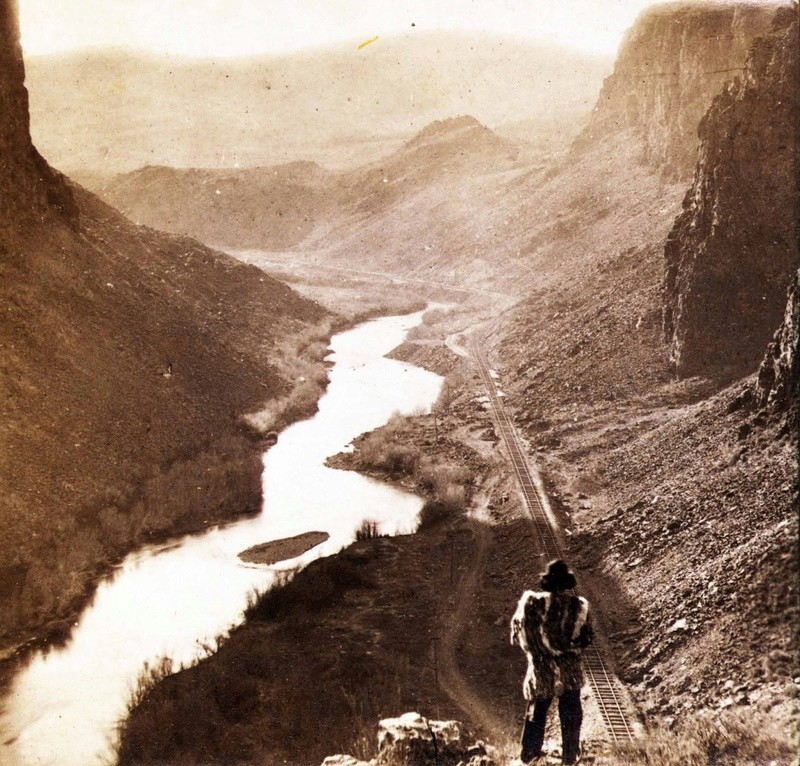
In this photograph by Alfred Hart taken between 1865 – 1869, a Native American looks down upon a newly completed section of the Transcontinental Railroad, 435 miles from Sacramento, California. The stark composition of both man and progress facing a distant haze conveys emotions as complex as the cultural impact behind America’s westward expansion. The railroad was a massive undertaking, with three companies building the 3,069 km (1,907 mi) line over six years. With the final “Golden Spike” driven into the ground in May 10, 1869, the revolution in transportation allowed a flood of people and goods to travel directly from Council Bluffs, Iowa all the way to Sacramento, California.
Although, by the 1860s, Native Americans had signed away the rights to much of their land in treaties with the federal government, they likely never imagined that a disruptive and massive system like the railroad would be constructed through their traditional hunting grounds. The construction of the Transcontinental Railroad had dire consequences for the native tribes, forever altering the landscape and causing the disappearance of once-reliable wild game. The railroad was probably the single biggest contributor to the loss of the bison, which was particularly traumatic to the native tribes who depended on it for everything from meat for food to skins and fur for clothing, and more.


Perfectspecimen-


 Posts : 14451
Posts : 14451
Join date : 2011-08-15
Age : 70
Location : Cambs / Golf del Sur
- Post n°422
 Re: Iconic Photographs
Re: Iconic Photographs
They have inflatable ones too Reg. Always queue up for one of those, they roll less.Mcqueen wrote:Life boats my arse, I watch them ferries in and out with about 4 life boats, One day


Campbell Brodie-


 Posts : 59106
Posts : 59106
Join date : 2011-08-13
Age : 69
Location : Scotland
- Post n°423
 Re: Iconic Photographs
Re: Iconic Photographs
Do you have to blow them up? I'm fecked after 2 balloons...

Adam Mint-


 Posts : 23101
Posts : 23101
Join date : 2011-10-07
Age : 59
- Post n°424
 Re: Iconic Photographs
Re: Iconic Photographs
Perfectspecimen wrote:They have inflatable ones too Reg. Always queue up for one of those, they roll less.Mcqueen wrote:Life boats my arse, I watch them ferries in and out with about 4 life boats, One day
Think Mr Farrell would disagree with that,,, the Netta Croan...
http://www.grantontrawlers.com/Trawlers/Netta%20Croan%20LH%20100.htm
Trawler leaves Granton (Edinbutgh) gets to Aberdeen catches fire, one dead, Farrell (not the most liked person I would say)... but not a pretty way to go,,, fish food...
Trawler leaves Granton, galley stove has just been lit, these stoves were like a giant AGA, run on diesel fuel, once lit they were on for the trip (approx14days), but they took a while to warm up, basically diesel dripped/ran down in to a cast iron frying pan where it burned, but when cold you basically had to build a mini bonfire in the pan with rags to get it started,,, now when cold all you need is a drip of fuel to keep it going until it heats up, when at working temperature you can pour the fuel in and it burns like a jet engine, but when cold fuel just builds up in the "frying pan burner" with only a surface flame, this is what happend in this instance, stoves lit just before start of trip, crew member wants a cup of tea or something so turns up fuel tap to max, all that's happening is fuel builds up in frying pan quicker than it can burn, fuel starts overflowing, where does it go, down the galley drain, where do all the accommodation drains go,,, the engine room bilge which is full of an oily mix,,, next thing stoves overflowing hot diesel that ignights and sets fire to engine room bilge,,, Now this was an old boat, telegraph control, ding ding and all that meaning an engineer in the engine room had to set the engine to the captains instructions... So engine room bilge bursts in to flames, engineers depart engine room quick leaving engine running at full speed,,, big mistake... So crew assemble boat deck, pull emergency engine fuel stop valves, launch life boat, but life boat in picture had been replaced with an inflatable dingy by this time, so crew launch the dingy and pull it up to the bow of the boat as far away from the engine room and fuel tanks with 8 ton (8000 litres) of fuel in them expecting them to go bang at any time, and wait for engine to stop as they're doing about 20/12 knots at the time, but engine don't stop,,, so they are all at the front (bow) of the boat expecting it to go bang at some time, so Farrell decides to jump in dingy that's being towed at 12 knots or so, big mistake,,, flips over,,, fish food...
Department of Trade inspectors arrive to carry out tests on a sister ship, I'm allocated to assist them, boat was direct drive, no clutch or gearbox, so boat is well tied to harbour, engine set at half speed and emergency valves pulled, DoT inspectors with stopwatches timing for the engine to stop, it didn't,,, so I strip emergency valve in their presence, it's full of silt/sand, it wasn't fully closing,,, now these valves were checked every six months by the DoT, but externally it looked as if the valve had closed, internally it had not,,, the fix,,, a 16th of an inch hole drilled in the stalk of the poppet valve stem holder to let the silt drain...

Campbell Brodie-


 Posts : 59106
Posts : 59106
Join date : 2011-08-13
Age : 69
Location : Scotland
- Post n°425
 Re: Iconic Photographs
Re: Iconic Photographs
Yeah... 









